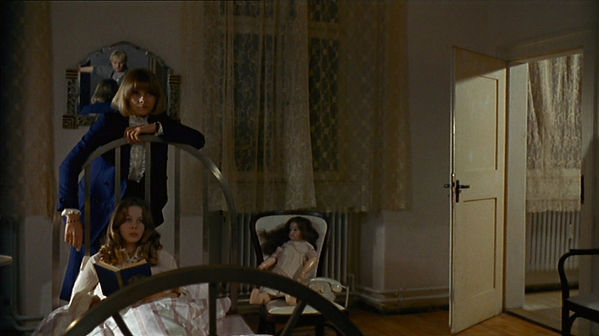AESTHETICS
OF
DECEPTION

Cinema and clothing have always had a deep, reciprocal relationship to each other since the inception of film as a medium of artistic expression. Films can live on for their fashionably rich legacies. While other films become resources of reference for fashion (Godard’s Breathless, for example). What ‘style’ means in the context of a film can, of course, mean any number of things, and for Rainer Werner Fassbinder style is most often equated with the unique and distinctive nature of his characters. Instrumental to creating such vivid and vivacious characters are the deep aesthetic levels Fassbinder layers onto each of his characters. Everything about them, including their garments, is meticulously and purposefully created and curated by the director. Clothing is an integral part of the iconography of Fassbinder’s more than 40 art-house films, as well as a representation of and window into his particular stylistic sensibilities.


Fassbinder’s use of garments as an integral part of the his films is featured prominently in one of his lesser-known works, Chinese Roulette, which was directed in a period of Fassbinder’s career where he was experimenting with different aesthetic modes with which to further and create narratives within his films. The film is lyrical, easy to understand, and primarily of interest for its avant-garde stylistic and aesthetic features.
The basic plot of Chinese Roulette follows eight characters a classic old-world and old-money chateau, presumably somewhere in West Germany. A man and his wife are purportedly taking separate business trips on the weekend, but unbeknownst to his wife, he has planned to take his mistress to their shared chateau. Meanwhile, his wife has also planned to take her lover (who happens to be the husbands executive assistant) to the same chateau. The child of their marriage is a hateful adolescent girl with a mute caretaker, and they share designs of disturbing everyone’s respective relationships. The couple and their respective lovers arrive at the chateau, overseen by a prickly housekeeper and her pseudo-intellectual son, and it seems that no one is very surprised or the least bit apologetic about the infidelities of the two couples. Each couple proceeds as they planned despite being revealed, until everyone’s plans are changed when the daughter of the couple decides she’d like to play a game of Chinese Roulette, and a haunting psychological thriller with a brilliant climax ensues.


Fassbinder unleashes a scathing critique of the emptiness of bourgeois culture, and comments on the breakdown of the traditional family unit against the gilded hell of European high culture. Broadly, Fassbinder addresses victimhood, manipulation, isolation, alliances, internal struggle and deception as mechanisms of existence amongst human beings.
Chinese Roulette achieves the gravity of its affects on the viewer through its aesthetics, of which clothing is a massively important component. The bold outfits of the characters guide our focus, acting as signifiers during sequences that have very little explanation. The stylistic direction of Chinese Roulette is one driven by symbolism, and garments are another aesthetic prism through which Fassbinder offers an understanding of his characters and his narrative to the viewer.




The son of the housekeeper dons a muted khaki uniform of so many of the New Left of the 1970s era, and it is very noticeably ill fitting and bizarrely styled. The implication, through his outfit, is that of a pretender - someone who aspires to be something he is not, reflected through poor execution of the image of a leftish intellectual. Soon after this, he is revealed as a fake anarchist, and an aspiring pretentious philosophical writer with little depth behind the image he has created of himself.
Anna Karina, long a muse of Jean Luc Godard, plays the mistress of the husband, and her conspicuous headgear and dark evening ware are integral in revealing her as a sordid, downtrodden soul and her status amongst her peers. Her outfit immediately positions to viewer to challenge their existing preconceptions of Karina and her frequent roles as a bubbly, charismatic women in Godard’s films. However, Anna Karina looks eternally beautiful and well dressed in Chinese Roulette much as she did in Godard’s films, so that much remains the same.


While not a garment, per say, a central object in Chinese Roulette are the crutches the couples’ daughter is confined to as a consequence of her illness. The most memorable scene in the film is perhaps her mute governess using them to dance to Kraftwerk, but the crutches ultimately emerge as a representation of how the aesthetic can belie reality, and can serve as a mask as to who really holds to power in human relationships. The power in Chinese Roulette does not belong to the strongly dressed husband in his opulent white dinner jacket, or his darkly handsome assistant in his rugged turtleneck. No, the one pulling the strings is the young girl, who ostensibly is restrained by the trappings of the two steel supports she is restricted to.
Characters in Fassbinder’s film wear the clothing of grace on the surface, while simultaneously the clothing comes to be a symbolic illustration of deception and power. Fassbinder was an avant-garde director who explored what was really possible to achieve in cinema, and his pushing of aesthetic boundaries and possibilities was no small part of this. After all, film critic Vincent Canby once said of Fassbinder, “[his] surfaces are like fashion shoots, but the more you admire the make-up, the more you notice what it’s desperately trying to hide: the scars of lifelong emotional combat.” Fassbinder was deeply attuned to the fact that Fashion is a way that we construct ourselves through artifice, and through his aesthetic techniques he leaves us with questions about the human condition. What defines life? What limits it? What is the role of aesthetics in our understanding of how we perceive and inhabit the world?



text: Aaron Grey
Recommended For You

